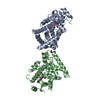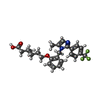Entry Database : PDB / ID : 7f80Title Co-crystal structure of Inhibitor compound MA-211 in complex with human PPARdelta LBD Peroxisome proliferator-activated receptor delta Keywords / Function / homology Function Domain/homology Component
/ / / / / / / / / / / / / / / / / / / / / / / / / / / / / / / / / / / / / / / / / / / / / / / / / / / / / / / / / / / / / / / / / / / / / / / / / / / / / / / / / / / / / / / / / / / / / / / / / / / / / / / / / / / / / / / / Biological species Homo sapiens (human)Method / / / Resolution : 2.8 Å Authors Lakshminarasimhan, A. / Rani, S.T. / Senaiar, R.S. / Krishnamurthy, N. Journal : To Be Published Title : Co-crystal structure of Inhibitor compound in complex with human PPARdelta LBDAuthors : Lakshminarasimhan, A. / Rani, S.T. / Senaiar, R.S. / Krishnamurthy, N. History Deposition Jun 30, 2021 Deposition site / Processing site Revision 1.0 Jul 6, 2022 Provider / Type Revision 1.1 Nov 29, 2023 Group / Refinement descriptionCategory / chem_comp_bond / pdbx_initial_refinement_model
Show all Show less
 Yorodumi
Yorodumi Open data
Open data Basic information
Basic information Components
Components Keywords
Keywords Function and homology information
Function and homology information Homo sapiens (human)
Homo sapiens (human) X-RAY DIFFRACTION /
X-RAY DIFFRACTION /  SYNCHROTRON /
SYNCHROTRON /  MOLECULAR REPLACEMENT / Resolution: 2.8 Å
MOLECULAR REPLACEMENT / Resolution: 2.8 Å  Authors
Authors Citation
Citation Journal: To Be Published
Journal: To Be Published Structure visualization
Structure visualization Molmil
Molmil Jmol/JSmol
Jmol/JSmol Downloads & links
Downloads & links Download
Download 7f80.cif.gz
7f80.cif.gz PDBx/mmCIF format
PDBx/mmCIF format pdb7f80.ent.gz
pdb7f80.ent.gz PDB format
PDB format 7f80.json.gz
7f80.json.gz PDBx/mmJSON format
PDBx/mmJSON format Other downloads
Other downloads 7f80_validation.pdf.gz
7f80_validation.pdf.gz wwPDB validaton report
wwPDB validaton report 7f80_full_validation.pdf.gz
7f80_full_validation.pdf.gz 7f80_validation.xml.gz
7f80_validation.xml.gz 7f80_validation.cif.gz
7f80_validation.cif.gz https://data.pdbj.org/pub/pdb/validation_reports/f8/7f80
https://data.pdbj.org/pub/pdb/validation_reports/f8/7f80 ftp://data.pdbj.org/pub/pdb/validation_reports/f8/7f80
ftp://data.pdbj.org/pub/pdb/validation_reports/f8/7f80
 F&H Search
F&H Search Links
Links Assembly
Assembly
 Components
Components Homo sapiens (human) / Gene: PPARD, NR1C2, PPARB / Production host:
Homo sapiens (human) / Gene: PPARD, NR1C2, PPARB / Production host:  Escherichia phage EcSzw-2 (virus) / References: UniProt: Q03181
Escherichia phage EcSzw-2 (virus) / References: UniProt: Q03181 X-RAY DIFFRACTION / Number of used crystals: 1
X-RAY DIFFRACTION / Number of used crystals: 1  Sample preparation
Sample preparation SYNCHROTRON / Site:
SYNCHROTRON / Site:  Australian Synchrotron
Australian Synchrotron  / Beamline: MX2 / Wavelength: 1.1 Å
/ Beamline: MX2 / Wavelength: 1.1 Å Processing
Processing MOLECULAR REPLACEMENT
MOLECULAR REPLACEMENT Movie
Movie Controller
Controller



 PDBj
PDBj

